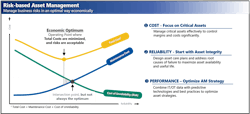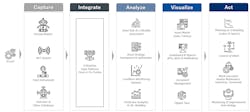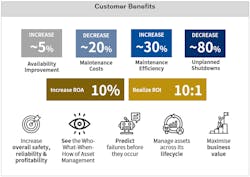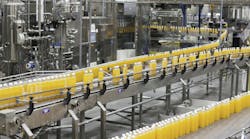The term asset management (AM) and the concepts behind it have evolved over recent decades. Early on, it was essentially maintenance management stemming from an effort to control costs and better direct activities. Back then, it used various techniques to determine equipment needs, typically experience-based, combined with scheduled procedures, such as periodic oil changes and bearing replacements. With the coming of smart field devices, AM grew to include automated diagnostic information to supplement manual surveys, but it was still basically maintenance management with some reliability concepts blended in.
More recently, the underlying concepts have evolved quickly with advances of smart devices, improvements in IIoT-based networking and highly sophisticated data analysis tools. In this article, we will look at how those changes have combined to create capabilities for managing assets over a process plant’s entire life cycle.
It’s a big job
A large-scale process manufacturing facility is comprised of many assets — easily in the tens-of-thousands of items — encompassing:
- Automation systems and networking components
- Field instruments
- Valves and actuators
- Pumps, compressors and other rotating equipment
- Vessels, reactors, heat exchangers, tanks and piping
- Boilers and fired heaters
- Additional assets
Each type of asset has its own characteristics and needs. Some assets are very strategic, and the loss of any one of them could cause a production interruption. Some have internal diagnostic capabilities, some have diagnostic sensors added, and some are only monitored manually.
Creating an AM system able to handle everything from a gas-turbine driven compressor to a quarter-turn shutoff valve calls for an enormous range of capabilities and versatility — with scalability to handle any imaginable number of individual assets.
What AM means today
As previously mentioned, AM originally started out as maintenance management and gradually added some reliability practices. Its more recent expansion into a far more comprehensive program has been aided by the development of the ISO 55000:2014 Standard. The International Standards Organization says it, “provides an overview of asset management, its principles and terminology, and the expected benefits from adopting asset management. ISO 55000:2014 can be applied to all types of assets and by all types and sizes of organizations.”
According to the ISO 55000 standard, “Asset management is a coordinated process of balancing acceptable risks, costs and desired asset performance throughout the asset lifecycle to achieve organizational objectives.” That statement says a lot, so let’s unpack the full meaning by separating it into four concepts.
1. AM extends beyond simply improving maintenance activities or fixating on asset performance monitoring. These are important elements, but the key concept of ISO 55000 is balance. Looking at the functions just mentioned, they involve different departments of a company. Operations, maintenance, reliability and corporate management are all involved to make sure full value is extracted from every asset. Each group carries out its specific functions to make sure this can happen every day. The functions for any given asset include planning the asset strategy, performing actual maintenance work, and monitoring its performance — all while continuously striving to improve the entire process, end-to-end. All this happens under the umbrella of overall corporate objectives.
2. AM must understand, quantify and manage risk. The company must have a concept of how any given asset affects production, as well as understand potential health, safety and environmental (HSE) impacts. To put it in other terms, what happens if this asset cannot do its job or fails in some way? Naturally, some are hugely critical, while others are far less important — high-risk versus low-risk. In the event of a developing problem, each of the four departments just mentioned may look at the situation differently. Operations wants to maximize output and keep running, while maintenance wants to do its job in the least costly way possible, often calling for a shutdown. These two legitimate and desirable interests may come into conflict, which is where the larger business interests come into play.
3. The ISO 31000 Risk Management Standard is based on providing “a level of reassurance in terms of economic resilience, professional reputation and environmental and safety outcomes. In a world of uncertainty, ISO 31000 is tailor-made for any organization seeking clear guidance on risk management.” In practice, the standard helps companies understand risks and perform risk analysis on assets to produce consistent, comparable and reliable results that stakeholders can understand and accept. AM utilizes a risk matrix that considers risk impact and likelihood for each asset, helping identify which are critical in terms of financial impact, compliance impact, safety and so forth. The next step is to define an asset strategy to mitigate risks so a company can realize its production, safety and profitability goals.
AM must be involved in capital expenditure (CAPEX) as well as operational expenditure (OPEX) activities. Traditionally, AM was seen as the group taking care of what is in the plant once it is already there, but AM supports CAPEX by ensuring the optimum equipment selection to meet the defined business needs and creating asset strategies to improve reliability and availability. When involved in the design and engineering, procurement, construction and commissioning phases, AM can ensure the asset can do its job once in the plant. In addition, data compiled during these phases will be used when the asset moves into the OPEX phase. The new asset should also include the kinds of diagnostic and networking capabilities needed to integrate completely into the AM environment.
4. AM ensures the highest return on assets. When an effective AM system is in use, a plant can reach the maximum number of goals simultaneously, including profitability and HSE. By using data from multiple sources, a facility can develop strategies to improve asset availability and reliability. This risk-based approach to the entire asset life cycle minimizes total cost of ownership by prioritizing decisions and resources from CAPEX to OPEX.
How AM balances two costs
AM is mainly concerned with two cost areas: maintenance and reliability (Figure 1). Let’s look at each individually.
If we want to increase the reliability of a facility, we spend more money to service and replace equipment. Reliability increases, but so do aggregate maintenance costs (blue curve).
Unreliability (risk) is trickier. It has an inverse relationship (green curve), so as reliability increases, the unreliability cost goes down. In other words, the more reliable a facility is, the less it is affected by risk. As the graph shows, the two curves intersect. This intersection point could be considered the optimum operating point but is not necessarily. The total cost (yellow curve) gives a better indication of the optimum point.
Some might look at this and say, “It’s wonderful but too theoretical to be useful. Who has that kind of data?” With today’s AM systems, it is far more practical than may appear at first glance. Risk management provides the framework to identify, assess and evaluate a company’s and facility’s acceptable risks. Multiple asset strategies — from breakdown to preventive to predictive maintenance — are applied depending on the asset risk and criticality ranking. This methodology is further optimized to balance against costs and desired asset performance.
Digital technologies — such as artificial intelligence, machine learning and digital twins — are part-and-parcel of today’s sophisticated AM systems and are critical to achieving risk-based asset management. With comprehensive data collection and analysis, it is possible to calculate the values just outlined with a degree of accuracy unimaginable by traditional methods.
The practical value of this is data to support failure analysis and asset care planning, capable of reducing the costs and risks of unexpected asset failures, and optimizing the use of limited maintenance resources. It is possible to identify maintenance needs early but initiate maintenance jobs only when needed. This shift from reactive to proactive asset care is possible with condition monitoring data, risk analysis and advanced analytics provided by AM.
Mechanics of AM
The work processes of AM go on continuously following the same five-step process (Figure 2), updated as often as required depending on the asset and risk assessment.
- Data on the assets is captured in the field using whatever method is appropriate, from manual checks to automated diagnostic data gathering.
- Captured data gets integrated into the great enterprise data lake, either on premises or in the cloud.
- Data analytics platforms review the new data using automated programs, or individual engineers can access it for specific projects.
- Analytics platforms present the data using a combination of programmed dashboards and reports, or specialized ad-hoc reports can be generated for specific projects.
- Recommended actions take all factors into consideration including operations, maintenance, reliability and corporate management. The analysis balances all the possible outcomes to take the right set of actions.
Execution of these steps is refined and improved over time based on experience and results.
Everything working together
So, what should be the expected results when a company deploys today’s AM systems (Figure 3)?
- Simplified AM through digitalization, with data and system integration to support predictive maintenance.
- Maximized return on assets with safe and sustainable performance.
- Balanced risks and costs to optimize profitability.
- A closed-loop solution with the right tools and work processes to drive continuous improvement and deliver sustainable excellence.
These days, especially with the limitations and challenges of COVID-19, the need to achieve corporate performance goals while reducing and optimizing costs is greater than ever. AM systems available today can improve performance in the short term and going forward. What’s more, implementing successful AM does not need to carry a multimillion-dollar price tag and take years to achieve practical benefits. Effective, fit-for-purpose solutions are available within the marketplace.
Keiichi Nishiyama is a senior manager and asset management leader at Yokogawa. He has over 20 years of global engineering and consulting experience in process automation and field digital technology solutions, as well as over 10 years of experience in asset management business development, sales, operations and services. Nishiyama remains passionate in developing industrial solutions that leverage traditional wisdom and modern digital technologies to improve the industry’s operational and strategic performance.





